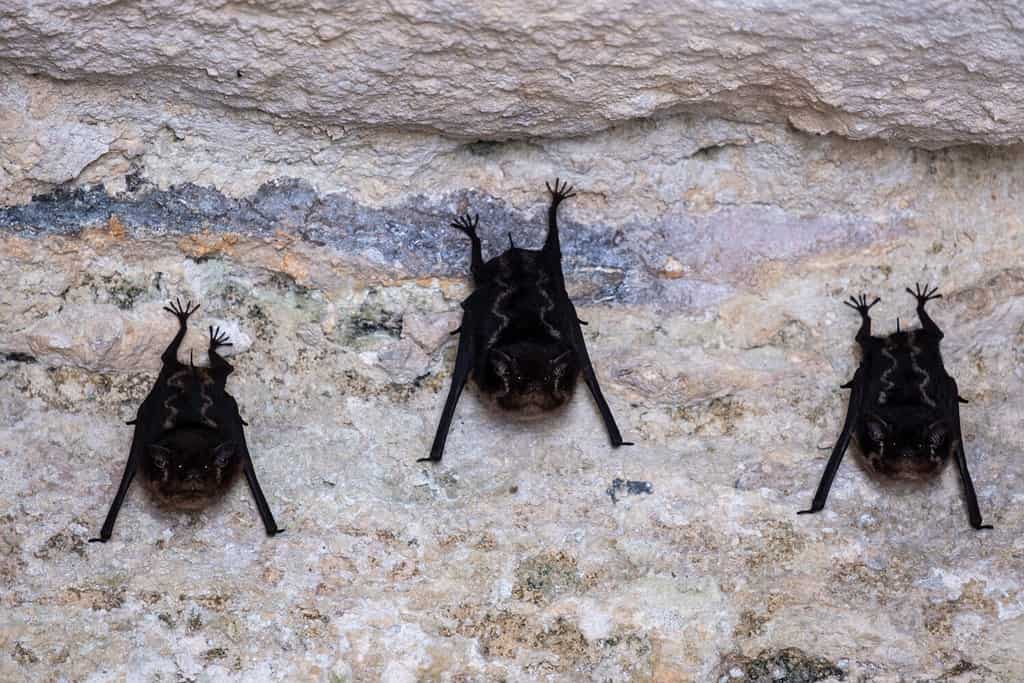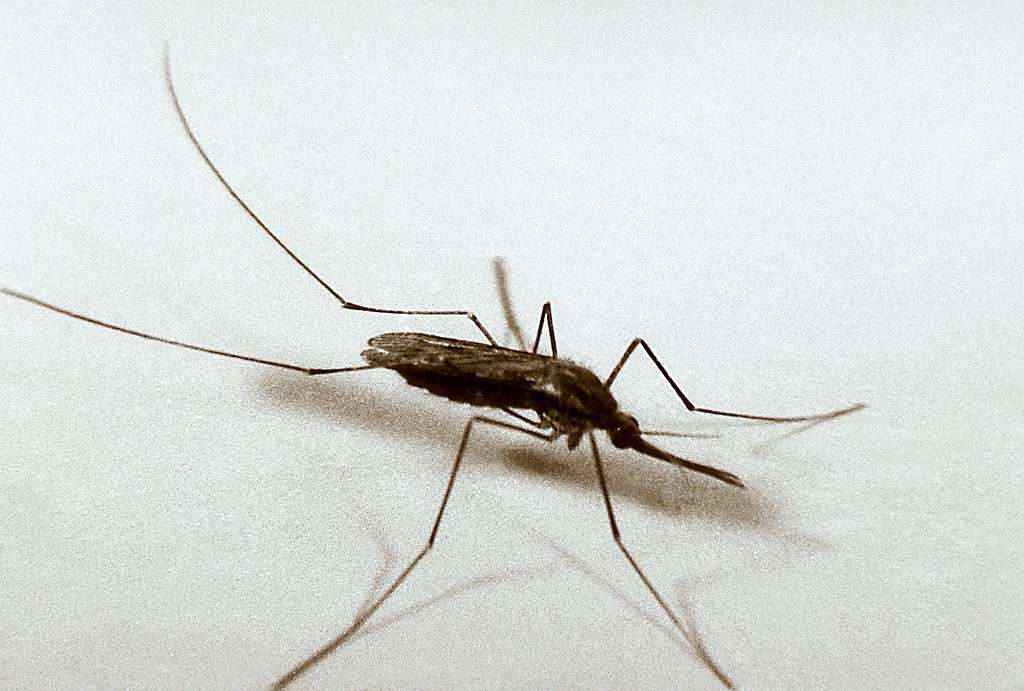Interested in learning about the most dangerous flying animals in Alabama? To be honest, there are not that many! Alabama doesn’t have many dangerous flying animals. However, there are a few animals you should watch out for, as the state does feature some dangerous creatures.
Keep reading to learn all about these potentially dangerous insects and how to avoid them.
1. Stinging Insects

Wasps are one of the more dangerous flying insects in Alabama.
©tasnenad/Shutterstock.com
Stinging insects are common in Alabama during the warmer months. These insects may play an essential role in pollination and insect control. However, they can pose a risk to humans and pets.
There are many different stinging insects in Alabama, including:
- Bees: Bees are essential pollinators that pollinate many plants in Alabama. Bees are one of the more docile and non-aggressive, especially when left undisturbed. However, they can sting if they feel threatened, and some bee species are more aggressive than others. Most bee stings cause localized pain, swelling, and redness, but some individuals may experience severe allergic reactions that require immediate medical attention.
- Wasps: Alabama has various wasp species, such as yellow jackets, paper wasps, and mud daubers. These species commonly build their nests in different locations, including eaves and tree branches. Wasps are more aggressive than bees, particularly when protecting their nests. Stings can be quite painful and may cause allergic reactions in some people.
- Hornet: Hornets are a particular kind of wasp known for their large, papery nest that can commonly be seen from trees and buildings. While hornets are similar to other wasps, they are more aggressive and more likely to sting. Their stings are potent and can cause serious pain and swelling.
You can reduce your risk of getting stung by these insects, though. In many cases, these insects don’t want to sting and aren’t aggressive. However, we can accidentally make them feel threatened, causing stings.
- Avoid Provoking Nests: Stinging insects are most defensive around their nests. Therefore, you should be extra cautious about upsetting nests. Don’t attempt to remove nests yourself, as this can be dangerous. Instead, seek professional help from a beekeeper or pest control specialist.
- Wear Protective Clothing: If you plan to participate in outdoor activities where there’s a likelihood of running into stinging insects, it’s best to wear long-sleeved shirts, long pants, and closed-toe shoes. This will help minimize the chances of getting stung.
- Use Caution when Eating: Food and sweet beverages can attract bees and similar insects. Therefore, it’s important to keep these beverages covered to minimize contact.
- Educate Children: Teach children about the importance of respecting stinging insects and what to do if they encounter them.
2. Bats

Healthy bats aren’t aggressive, but they can carry diseases.
©LP Production/Shutterstock.com
Bats are ecologically significant creatures. They’re very important to the environment, as they help control the insect population. Plus, they’re the only mammals capable of flight. However, they should be treated with caution and respect to minimize any potential risk.
Just like most other mammals, bats can carry rabies. However, the chances of bats carrying rabies are quite low, and most bats are not infected. It is extremely important to avoid handling bats or any other wild animals to reduce the risk of getting exposed to potential diseases.
Alabama is home to several bat species, including the little brown bat, big brown bat, Eastern red bat, hoary bat, and others. The northern long-eared bat, a federally threatened species, also resides in the state.
They tend to be most active during the night and come out at dusk to hunt for insects. Before dawn, they return to their roosts. However, if you happen to come across a bat during the day, it could be a sign of illness or distress. It’s best to avoid direct contact and inform the local wildlife authorities to ensure the bat’s safety.
Bats are experiencing lowering populations due to habitat loss, disease, and other factors. You can help bats by installing bat houses on your property that can provide shelter for bats and encourage their presence. These houses can be a great pest control option.
If you encounter a bat, stay calm and avoid direct contact. If a bat is in your home, open escape routes like windows and doors and give the bat space. Contact a local wildlife professional who can assist with removing the bat if necessary.
3. Birds of Prey

Alabama is home to many different birds of prey.
©Marcin Perkowski/Shutterstock.com
Birds of prey are common in Alabama. Many birds of prey inhabit various ecosystems, including wetlands, grasslands, and even urban areas. While these birds are not inherently dangerous to humans, they shouldn’t be startled or threatened.
Birds of prey, especially during their breeding season, may exhibit defensive behavior if they feel their nests or young are threatened. Raptors like hawks and owls can swoop down or dive at perceived threats, leading to potential injury if individuals get too close to their nests.
These birds may also pose a small risk to tiny dogs and other pets. They are predatory and may see these animals as food. However, birds of prey weigh very little and cannot pick up very much. Therefore, most dogs and cats are safe.
Birds of prey do have sharp talons and beaks designed for catching prey. While they primarily use these features for hunting, accidental contact with their talons or beak can result in scratches or puncture wounds. Therefore, you should always keep a safe distance from these birds.
As with any wild animal, there is a potential risk of disease transmission. For instance, some birds of prey can carry bacteria or parasites, and their droppings can be a source of disease if proper hygiene precautions are not taken.
4. Mosquitoes

You’ll find tons of mosquitos in Alabama.
©https://pixnio.com/fauna-animals/insects-and-bugs/mosquito/close-up-photograph-of-an-anopheles-quadrimaculatus-mosquito-on-white-background# – Original / License
Mosquitoes are a prevalent and hazardous pest in Alabama, as well as other areas with warm and humid weather conditions. These small flying insects are part of the Culicidae family and can transmit illnesses to humans and animals through their bites.
Mosquitoes are vectors for several potentially harmful diseases in Alabama. When these animals feed on a human or animal, they can transmit these diseases to them. Here is a list of diseases that may occur in Alabama:
- West Nile Virus: This viral infection can present with flu-like symptoms. However, it can be quite severe in some individuals, such as older adults and those with weakened immune systems.
- Eastern Equine Encephalitis: EEE is a very rare but potentially deadly disease. It can infect humans, despite the name. It impacts the central nervous system.
- Zike Virus: Although less common, Zika virus infection can be dangerous for pregnant women as it can lead to birth defects in their babies.
- Chikungunya and Dengue: These diseases can lead to high fever, joint pain, and other severe symptoms in rare cases.
Beyond disease transmission, mosquito bites are irritating and can cause red, itchy bumps. While these bites are usually harmless, excessive scratching may lead to skin infections.
Mosquitos require still water to breed. The humid climate in Alabama is perfect for mosquitos. Therefore, if you have stagnant water on your property, consider removing it. Ponds, ditches, and containers can all be breeding grounds for mosquitoes.
There are many ways you can minimize the risk of mosquito-borne diseases. The best way is to keep insects away from you. Applying insect repellent containing DEET, picaridin, or oil of lemon eucalyptus can help protect against mosquito bites. You should also wear protective clothes when possible, like long sleeves and pants.
Install mosquito screens wherever you can, especially on doors and windows. These screens help keep mosquitos out of living areas. You may also add mosquito-deterring plants to your garden or yard.
Mosquitoes are most active during dawn and dusk, so minimizing outdoor activities during these times can reduce exposure to bites.
Local health departments and authorities in Alabama also implement mosquito control measures, such as larvicide treatments and mosquito population surveillance, to reduce mosquito populations and the risk of disease transmission.
Summary of the Top 4 Most Dangerous Flying Animals in Alabama
| Number | Animal |
|---|---|
| 1 | Stinging Insects |
| 2 | Bats |
| 3 | Birds of Prey |
| 4 | Mosquitoes |
Thank you for reading! Have some feedback for us? Contact the AZ Animals editorial team.







